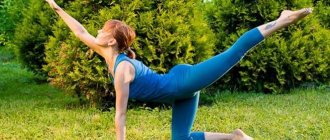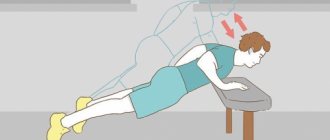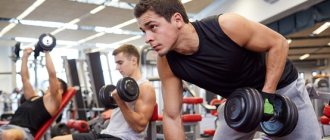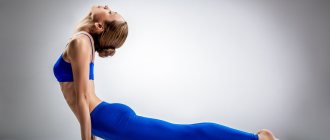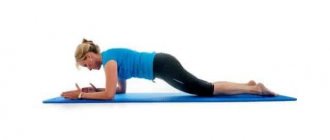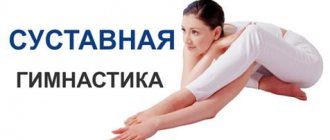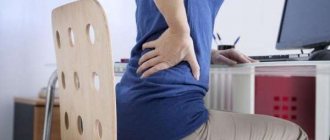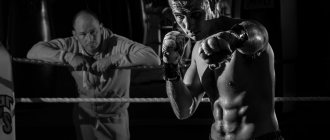In the generally accepted understanding, body flexibility is the prerogative of yogis, gymnasts and circus acrobats. An ordinary person does not need to do the splits, lotus position, or touch his big toe to his earlobe. But flexibility, it turns out, is not just the ability to perform gymnastic tricks. Posture, a harmonious, even silhouette and the health of the spine depend on how flexible the back is.
Exercises for back flexibility
Why the back should not only be strong
A healthy, fully developed back should bend, bend, and twist without problems. If, in the absence of spinal diseases, you have problems with back mobility and limited movement, it means that rigid, inelastic muscles do not allow you to achieve the full range of motion. And it will get worse. The natural flexibility inherent in the human spine will gradually be lost, the back will be in a static position most of the time, which will lead to the development of spinal diseases and atrophy of the spinal muscles.
By the way. Among young people, especially men, there is an opinion that the back must be strong. This is partly true for those who “swing”, since in their case the back serves as a lever that transmits force to the muscles during a strength exercise. But along with strength, the back must have flexibility. Otherwise, it is very easy to “break it” during strength training.
It is important that your back is not only strong, but also flexible.
The back muscles must be strong for another reason, to protect the spine from injury. Strong does not mean pumped up, but elastic, stretched, flexible. If a person cannot bend over and reach, bending over, with his hand to the floor, it is not spinal diseases that are to blame, even if they are present, but the rigid, undeveloped muscles of the back and abs.
Back flexibility is achieved through muscle training
Important! A healthy spine bends forward, extends backward, tilts the body laterally, and twists in both directions.
If the muscles are not trained, not flexible, this gives rise to a lack of movement in the full range, resulting from this situation, problems with posture, pain and various back diseases.
If the back muscles are not trained, then the risk of developing spinal diseases is high.
The spine is the axial frame of the body, complexly designed and providing in one way or another the support and vital functions of many organs, almost the entire body. But with age and under the influence of stress, its functioning is impaired. There is a crunch in the cervical vertebrae, lower back pain, and limited movement. All of these problems can be prevented or their occurrence delayed for a long time if you regularly do exercises to stretch and increase the flexibility of the spine.
By doing exercises, you can prevent the occurrence of crunching of the vertebrae and back pain
- A person constantly strains his back muscles.
- Moves little.
- Chooses sedentary work.
- Lifts weights, including in the gym.
- Doesn't eat right.
- Doesn't maintain good posture.
- Sleeps on an uncomfortable bed.
- Does not have muscle relaxation skills.
Of course, not everyone does this, but this collective image is familiar to many who do not care about their health and flexibility of the spine.
Physical inactivity and poor lifestyle can lead to problems with the spine
Important! The back muscles need two important things to function properly: training and relaxation. During the day, this is the movement that is so lacking for those sitting in offices and at computers, behind the wheel and at desks. At night - rest, which should be carried out on a suitable pillow and anatomical mattress.
If you do not follow these important rules, the muscles will be constantly under tension, cause pain, and will not allow you to work and live fully.
Where to start the exercises?
In order for stretching to bring results and improve the flexibility of the spine, it is necessary to perform the exercises correctly. It is recommended that the first training be carried out under the guidance of an instructor. Then you can do stretching on your own. How to prepare for training:
- Make sure you wear comfortable clothes.
- Find a convenient place.
- Assess your health status - if there is pain or discomfort, it is better not to exercise.
- Do a warm-up.
- Tune in to proper breathing.
In the first lessons, you need to repeat the exercise no more than 8 times. Then the number of repetitions can be increased to 15. If breathing becomes difficult, you need to take short breaks. But you shouldn't sit on the sofa or just stand. You need to constantly be on the move, you can take a few sips of still water. Today in every city you can find a fitness room where they conduct stretching training (another name for stretching). Mostly, they study three times a week for an hour.
Flexibility and health
If you look up the meaning of the word flexibility in the dictionary, it will become clear that this concept means a person’s ability to perform various movements with a large amplitude. How does this opportunity affect health? Direct.
Table. The importance of flexibility for health.
| Meaning | Description |
| How much energy does a person spend per day? Whatever this figure is, which depends on the individual, energy costs can be reduced. Each muscle in the body can be in two states. When it contracts, a person is tense, when it is stretched, he is relaxed. The more time a muscle spends in the contraction position, the more energy it requires. This is why a person who does not know how to stretch his muscles experiences occasional or constant fatigue. Increasing muscle flexibility not only relieves tension, but also frees up the energy used to keep the muscles contracted. |
| Flexibility not only gives relaxation, but also gives muscle tone. And since the tone is distributed evenly when the free muscles are not tightened, coordination of movements increases. A flexible person can acquire any physical skills much faster than someone who is not highly flexible. |
| Tense muscles actively signal to the nervous system that they are in a state that is far from normal, causing the consciousness to become distracted, tired, and the nerves to wear out. Stretching and relaxing muscles leads to relaxation of the body and stops sending alarming signals about overexertion to the brain. Nerves become more resilient, concentration increases. |
| Blood vessels consist of two important components - muscular and elastic. When flexibility develops, elasticity is trained, because if it is poorly developed, blood flows poorly through the vessels and varicose veins develop. Flexibility exercises thus help promote good blood flow, which makes it easier for the heart to work and prevents bleeding. |
| If the body does not have flexibility, the vessels in it are used unevenly. Some of them do not work at full capacity, while others take on the entire load. When muscles become flexible, blood vessels stretch, distributing blood flow evenly and regulating blood pressure. |
| During exercises that increase flexibility, the body sends many signals to the central nervous system, receiving reflex responses in all organs. This stimulates and improves the quality of their work, improving the functioning of the immune, genitourinary, cardiological, nervous and respiratory systems. |
By the way. In Chinese culture, maintaining and improving health begins with developing flexibility in the muscles of the entire body, especially the back muscles.
How to increase the effect of training?
To make exercises to improve back flexibility more effective, you can use back exercise machines for your home. It is important to choose a projectile that is most suitable for this, for example, a roller. There are several more recommendations that will help both men and women improve the effect of each workout.
- You only need to exercise in comfortable clothes so that they allow the skin to breathe and do not restrict movement. For example, in clothes for Pilates.
- You should completely avoid shoes to improve blood flow during exercise.
- Back stretching exercises are best done on a yoga mat or special mat.
- The lesson should begin by warming up the muscles. Even a small warm-up will help you prepare well and make it easier to bear the load. This could be jumping in place, body turns, squats, or more.
- When using a back stretching machine, you should avoid jolts or sudden movements, and the number of repetitions should be increased gradually.
- You need to exercise at least 4 times a week, and the lesson itself should last 15-20 minutes. This will allow you to achieve good results without spending a lot of time.
Exercises for back flexibility are universal and are usually recommended for everyone, but before starting, it is better to consult with a specialist if you have joint pain, heart pathology, or have previously suffered spinal injuries. For the rest, a lesson on improving flexibility can be included in your morning exercises.
Set of exercises
To warm up, you can do a small number of forward and side bends and twists while standing. Then - exercises on a gymnastic mat.
Exercise one
Kneel down and place your hands on your buttocks.
Initial position
Using a sliding motion, move them down along the thighs, while simultaneously bending as far back as possible. The pelvis moves forward, the head is thrown back. Then sit on your heels and bend forward, rounding your back, touching your chin to your chest. Hands go down to the knees along the front of the thighs.
Exercise 1
Exercise two
From the position of the first exercise - side twisting. One hand, the one in which the twist is performed, touches the heel. The second one is raised up. Semicircle in one direction, then in the other. Then sit on your heels and round your back, drawing in your stomach.
Exercise 2
Exercise three
Standing on all fours, the well-known “Cat” exercise is performed. Pay special attention to the depth of the back arch and raising your head up. And also, so that the back is rounded as much as possible, and the chin is pressed to the chest in an arch. The knees are strictly under the pelvis, and the palms are under the shoulders.
Exercise 3
Exercise four
From the pose on all fours, move your arms forward with a sliding movement, lowering your chest until it touches the floor. The pelvis remains at the top. From this position, sliding your arms and legs in opposite directions, slowly lie down.
Exercise 4
Exercise five
Lying supine with your arms and legs extended wider than your shoulders, perform swings simultaneously with your right arm and the opposite leg. Then change limbs. The maximum amplitude is possible without bending the knees.
Exercise 5
Exercise six
From a supine position, raise your head, shoulders and legs, grab your ankles with your hands and lift your whole body so that your hips and chest come off the floor, and only your stomach is in contact with this plane. Release your ankles, spread your arms to the sides and hold in this position for 30 seconds. The head is thrown back.
Exercise 6
Exercise seven
Lie down. Bend your arms at the elbows and rest your palms on the floor at chest level on both sides of the body. Helping yourself with your palms, without lifting your chest from the floor, slide back, lifting your buttocks up. Then sit on your heels, stand with your back rounded, on your knees, lower your hips to the floor, bend back and lie down again in the starting position.
Exercise 7
Exercise eight
Take a position on your back, bend your knees, pull your heels towards your buttocks, and grab your ankles with your hands. Raise your pelvis and stand on the half-bridge. Shoulders are lifted off the floor, hands on the back of the waist, thumbs on the spine. After 30 seconds, carefully lower yourself to the starting position. Pull your knees to your chest and relax.
Exercise 8
Exercise nine
From the previous position, stand on the half-bridge. Then bend your lower back so that your pelvis reaches toward the floor.
Exercise 9
Exercise ten
The starting position is half bridge. Lift off the floor and lift up first one, then the other leg. Supporting your lower back with your hands, straighten your legs up and stay in this state for 30 seconds. Carefully, through the bridge, lower yourself to the floor.
Exercise 10
Exercise eleven
From a supine position, place your palms under your shoulders and rise into a full bridge. Straighten your arms and legs. You can alternately raise one or the other leg. Very carefully return to the floor. Press your knees to your chest, relax your muscles.
Exercise 11 - bridge
Exercise 11 - with lifting legs alternately
You can develop back flexibility at any age, in any weight category. But if you are overweight, you need to perform the exercises with double caution and increase the amplitude very slowly. But, after just a month of regular exercise, back pain will go away, the condition of blood vessels will improve, blood flow will normalize, posture will begin to improve, and you will feel good and in a good mood. And, by the way, do not forget, after a month of systematically doing gymnastics for the flexibility of the spine, get on the scales. The results will definitely please you.
Video - Flexible back exercises for beginners. Develop a flexible and strong back at home
Exercises for a flexible back
Flexibility can be developed at home or in the gym. Cross rolls are universal, but often go by different names, although they imply the same movement. For example, a cat, a cow or a dog are the same state that came from yoga. The task is universal, suitable not only for back flexibility. To perform this, a couple of meters of free space is enough, and there is no need for additional equipment.
Technical execution requires emphasis on the knees and palms, this is the starting position. Next, you need to slowly round your back, pushing it up as much as possible in the form of an arch. You need to stay in the position for 5 seconds, then smoothly change position. In a state with an arched back, you need to lower your stomach down as much as possible with a feeling of strong stretching and move your back in the lumbar region.
The neck moves depending on the phase of the exercise and can be at the bottom, in its natural state, or at the top. In the upper position, you need to bring your shoulder blades together.
Stretching against a wall is ideally performed with a special choreographic machine. If you don’t have equipment, you can place yourself near a wall, to which you need to stand sideways at a step distance, but this aspect depends on your height, so it’s better to check the correct placement using a thematic picture. You need to bend towards the vertical, using your hand as a support, so that it is parallel to the floor.
The second hand seems to reach towards the wall until you feel a stretch in the latissimus muscles. It is recommended to stay in the position for 5-7 seconds, after which the hand changes to another position. In a sports hall, you can use any exercise machine that allows you to fix the position of your torso in the required state.
Another exercise performed against a wall is quite similar to the cat/cow movement. Here the lumbar and cervical spine are better stretched. Any place where you can take the initial emphasis, but you can hold on to the simulator, is suitable for implementation.
Symptoms - clinics in
Choose among the best clinics based on reviews and the best price and make an appointment
Family
Oriental Medicine Clinic "Sagan Dali"
Moscow, prosp.
Mira, 79, building 1 Rizhskaya
+7
- Consultation from 1500
- Diagnostics from 0
- Reflexology from 1000
0 Write your review
Family
Clinic "Diamed Maryina Roshcha"
Moscow, Sheremetyevskaya st., 27, 1st floor
Maryina Roshcha
8
- Consultation from 1600
- Shock wave therapy from 1200
- Reflexology from 2200
9 Write your review
Family
Medical Center for Immunocorrection named after. R.N. Khodanova
Moscow, st.
Davydkovskaya, 6 Slavyansky Boulevard
+7(499)445-40-83
- Reception from 1500
- Diagnostics from 200
- Hirudotherapy from 1150
10 Write your review
Show all Moscow clinics
Symptoms - specialists in Moscow
Choose among the best specialists based on reviews and the best price and make an appointment with
Therapist
Batomunkuev Alexander Sergeevich
Moscow, prosp.
Mira, 79, building 1 (Oriental Medicine Clinic “Sagan Dali”) +7 0 Write your review
RheumatologistTherapist
Perelygina Elena Viktorovna
Moscow, Landyshevaya st., 14, bldg. 1 (Medical)
+7
0 Write your review
Therapist
